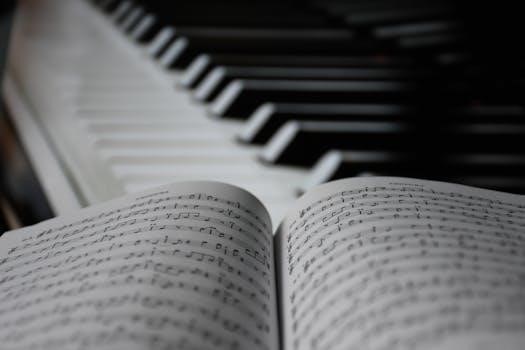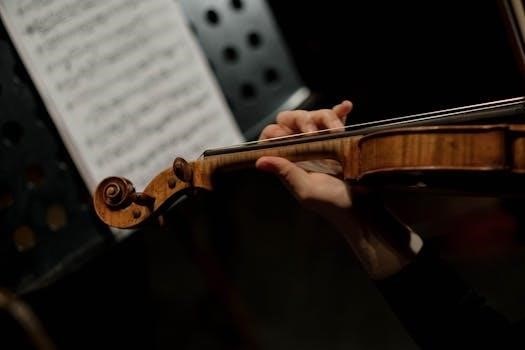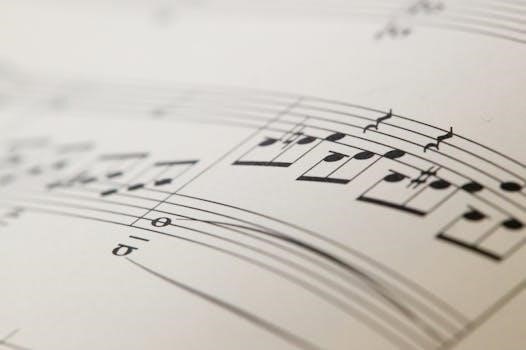
Franz Liszt’s Étude No. 6 in A minor, part of the Grandes études de Paganini, is a challenging and virtuosic piece. This etude is based on Paganini’s Caprice No. 24, featuring theme and variations. It is known for its technical demands and expressive potential, often requiring a high level of skill from the performer.
Overview of the Paganini Etudes
Liszt’s Paganini Études, also known as the Grandes études de Paganini, are a set of six piano études that are based on Niccolò Paganini’s 24 Caprices for solo violin. These études are not mere transcriptions, but rather elaborate reworkings that showcase Liszt’s innovative piano techniques. Each etude explores different aspects of virtuosity, emphasizing technical challenges such as fast octaves, rapid leaps, intricate fingerwork, and arpeggiated chords. They go beyond mere technical exercises, displaying musicality and expressive depth. The set was initially published in 1838 as “Études d’exécution transcendante d’après Paganini”, and later revised and simplified in 1851, becoming the “Grandes études de Paganini”. The revised versions are the ones most commonly performed today. The etudes not only serve as technical studies, but also as vehicles for musical interpretation, making them essential pieces in the repertoire of advanced pianists. Each etude presents unique challenges, demanding precision, speed and control from the performer.

Detailed Analysis of Etude No. 6
Étude No. 6 in A minor is a theme and variations structure. It is known for its rapid passages and complex fingerwork. The piece requires a high level of dexterity and musicality to execute effectively.
Key and Form of Etude No. 6
Liszt’s Étude No. 6, a cornerstone of the Grandes études de Paganini, is firmly rooted in the key of A minor. This choice of key lends a dramatic and often melancholic character to the piece. The etude is structured as a theme and variations, drawing its core melodic material from Paganini’s Caprice No. 24. The initial theme is presented with a clear and somewhat straightforward articulation, allowing the listener to grasp the underlying melodic structure. Following this, a series of variations unfold, each exploring different technical and expressive possibilities inherent in the theme. These variations showcase Liszt’s mastery of keyboard writing. The variations range from delicate and lyrical passages to powerful and technically challenging sections, demanding a wide range of skills from the performer. The form is not a strict adherence to typical variation form, but rather a free exploration of the theme’s potential, creating a sense of continuous development throughout the piece. The constant shifts in texture and tempo make the etude a demanding yet rewarding experience for both the performer and listener. The use of A minor provides a consistent tonal grounding, while the variations introduce variety and contrast.
Technical Challenges in Etude No. 6
The technical hurdles presented in Liszt’s Étude No. 6 are considerable, placing it among the most challenging pieces in the piano repertoire. The etude demands exceptional finger dexterity, requiring rapid and precise passages, often involving complex leaps and intricate figurations. One of the primary difficulties lies in the rapid arpeggiated chords, especially in the right hand, where the melody notes must be emphasized as the final notes of each arpeggio. These require a high degree of control and coordination. Additionally, the piece features numerous octave passages and fast scales that demand considerable strength and stamina. The variations explore a wide range of pianistic techniques, including legato, staccato, and rapid repeated notes. This requires not only technical proficiency but also the ability to shift seamlessly between different styles. Furthermore, the etude is full of extended hand positions and stretches, demanding flexibility and a strong hand span. The combination of these elements makes it a true test of a pianist’s technical prowess, requiring years of dedicated practice to master fully and execute with precision. The sheer speed and accuracy required add to the difficulty, making it a demanding but rewarding challenge.
Musical Interpretation of Etude No. 6
Beyond its technical demands, Liszt’s Étude No. 6 calls for a sophisticated musical interpretation, requiring the performer to bring both virtuosity and expressiveness. The piece, based on Paganini’s Caprice No. 24, is not merely a display of technical prowess; it’s an exploration of varied moods and characters. The theme and variations structure allows for a wide range of interpretive choices, from the delicate and light leggiero passages to the dramatic and powerful fortissimo sections. The arpeggiated chords, while challenging technically, must be shaped to create a sense of harmonic richness and melodic flow. The performer needs to bring out the contrasting textures and dynamics, highlighting both the melodic lines and the accompanying figurations. Furthermore, the piece should convey a sense of narrative, moving from the initial statement of the theme through its transformations in each variation. It is essential to find the balance between technical precision and emotional depth, allowing the music to speak with both clarity and passion. The interpretation should also reflect the improvisational spirit that is often associated with Liszt’s style, while still maintaining a sense of structure and coherence. Ultimately, the goal is to present a compelling and engaging performance that captivates the listener.

Sheet Music Resources
Finding sheet music for Liszt’s Etude No. 6 is relatively easy, with various options available. Resources include free PDF and MIDI downloads, official publishers, and arrangements for different instruments, catering to varied needs and preferences.
Free PDF and MIDI Sheet Music Availability
Numerous websites offer free PDF and MIDI files for Liszt’s Etude No. 6, making it accessible to a wide range of musicians. These resources often include both the original version and various arrangements. Several platforms provide downloadable scores, typically in PDF format, allowing users to print and study the music at their convenience. MIDI files are also available, enabling users to listen to synthesized performances and analyze the piece. Websites like IMSLP, SheetMusicPlus, and others host these digital versions, often with user-submitted scores and arrangements. Furthermore, some platforms offer both free and premium options for accessing sheet music, providing choices for musicians with different budget constraints. These free resources cater to students, educators, and enthusiasts, providing the opportunity to engage with this challenging piece. These digital files typically include multiple pages of music and are easy to download and print. Users can also find fingered versions, which can help with the technical demands of the piece. Some sites also offer variations and arrangements, suitable for different skill levels and instrumental setups. The availability of free PDF and MIDI files makes this complex work more widely available for study and performance.
Official Sheet Music Publishers
For those seeking professionally edited and printed versions of Liszt’s Etude No. 6, several reputable publishers offer official sheet music. G. Schirmer, Inc. is a well-known publisher that provides editions of the Grandes études de Paganini, including Etude No. 6. These official publications are often preferred by serious students and performers due to their accuracy and attention to detail. These editions often include fingering suggestions and editorial markings to help with interpretation. Sheet Music Plus is another source, offering both physical copies and digital downloads of officially published music. These versions are usually meticulously edited and printed, ensuring a high-quality product. Official editions may also include historical context and performance notes, providing additional insight into the piece. Additionally, some publishers may offer editions with different levels of difficulty, catering to a wider range of skill sets. These official sources are often the go-to choice for musicians preparing for performances, competitions, or auditions because of their reliability. Many reputable publishers have a catalog of Liszt’s works, making it easy to find a quality edition.
Variations and Arrangements
Beyond the original solo piano version of Liszt’s Etude No. 6, there exist several variations and arrangements that showcase its versatility. Liszt himself created variations within the etude, exploring different technical and musical aspects of the theme. Additionally, the piece has been arranged for other instruments and ensembles, including piano duets and transcriptions for other instruments. One notable arrangement is the Liszt-Busoni version, which offers a unique interpretation of the etude. Some composers and arrangers have taken the thematic material and created new works based on it, further expanding the repertoire related to this famous etude. These arrangements can provide different musical perspectives and insights into the original piece. These variations often explore different technical challenges or musical textures, offering a fresh take on the familiar theme. Exploring these variations can provide performers and listeners with a deeper understanding of the underlying structure and musical possibilities inherent in the original etude. Additionally, these variations offer alternative ways to experience Liszt’s compositional genius. The diverse range of arrangements testifies to the enduring appeal and flexibility of Etude No. 6.

Performance and Difficulty
Liszt’s Etude No. 6 is considered extremely challenging, demanding a high level of technical proficiency. It is known for its rapid passages, large leaps, and intricate fingerwork, making it a true test of a pianist’s skill.
Comparison to Other Liszt Etudes
When comparing Liszt’s Etude No. 6 to other études in his extensive repertoire, particularly within the Paganini Études and the Transcendental Études, several distinctions become apparent. Unlike the more lyrical and melodic qualities found in some of the Transcendental Études, such as “Feux Follets” or “Ricordanza,” Etude No. 6 focuses intensely on technical virtuosity, emphasizing rapid scales, arpeggios, and wide leaps. While “La Campanella” (Paganini Étude No. 3) is also technically demanding, Etude No. 6 is often cited as more challenging due to its complex variations and relentless pace. Furthermore, while some études like “Mazeppa” from the Transcendental set aim for a programmatic narrative, Etude No. 6 remains more focused on exploring the technical possibilities of the piano. The sheer density of notes and the constant demand for precision make it stand out even among other demanding Liszt works, often being regarded as one of the most technically strenuous of all his études. The etudes showcase different facets of pianistic brilliance, with Etude No. 6 representing the pinnacle of technical challenge.
Level of Difficulty and Required Skills
Liszt’s Etude No. 6 is widely considered to be one of the most technically demanding piano pieces in the standard repertoire. It requires an extremely high level of virtuosity, pushing the pianist’s skills to their absolute limits. The piece is characterized by rapid passages, intricate fingerwork, and wide leaps that demand both precision and speed. A performer must possess exceptional finger dexterity, strength, and endurance to navigate the complexities of the score. Furthermore, a deep understanding of musical phrasing and dynamic control is essential for conveying the piece’s expressive intent. The constant shifts in register and articulation require a highly developed sense of rhythmic accuracy and control. This etude is not for the faint of heart; only pianists with many years of dedicated practice and advanced technical proficiency can successfully tackle the challenges posed by this demanding work. Successfully mastering the etude is a testament to a pianist’s exceptional skill and musicality, and the piece is often considered a benchmark of advanced piano technique.

Additional Information
Liszt’s Grandes études de Paganini, including Etude No. 6, were revised in 1851 from an earlier version. This set is based on Paganini’s violin caprices. The pieces are known for their technical difficulty and are often performed by advanced pianists.
Historical Context and Publication Date
Franz Liszt’s “Grandes études de Paganini,” which includes Étude No. 6 in A minor, are a significant part of his repertoire. These etudes are not original compositions; instead, they are heavily inspired by Niccolò Paganini’s 24 Caprices for solo violin. Liszt, deeply impressed by Paganini’s virtuosity, decided to adapt and reimagine these caprices for the piano. The initial versions of these studies appeared in 1838. However, Liszt revised them considerably, publishing the final form, known as the “Grandes études de Paganini,” in 1851. Etude No. 6 specifically is a set of theme and variations, drawing directly from Paganini’s 24th Caprice; The 1851 publication marks the definitive version most commonly performed today. The etudes were created during the Early Romantic period, a time when composers pushed the boundaries of technical difficulty and expressive possibilities in music. The 1851 edition, published by Breitkopf & Härtel, has become the standard version for pianists. This period also saw a rise in piano virtuosity, which Liszt himself exemplified. The etudes served as both technical exercises and performance pieces.
Notable Performances and Recordings
Liszt’s Étude No. 6 has been a staple in the repertoire of many virtuoso pianists, leading to numerous notable performances and recordings. Among the most acclaimed is Marc-André Hamelin’s live performance, known for its exceptional clarity and technical mastery. The piece’s demanding nature often attracts pianists who seek to demonstrate their skills, resulting in a diverse range of interpretations. Several recordings of the complete “Grandes études de Paganini” feature highly regarded renditions of Etude No. 6, often praised for their musicality and technical precision. These performances can serve as inspiration for students and performers alike. Furthermore, the piece has been included in various recital programs and concerto appearances, highlighting its status as a benchmark for piano virtuosity. The availability of both audio and video recordings has allowed a global audience to appreciate the challenges and beauty of the etude. The historical significance of these recordings lies not only in showcasing technical prowess, but also in preserving diverse approaches to Liszt’s music. Some artists focus on the technical brilliance, while others emphasize the lyrical and expressive qualities of the piece.